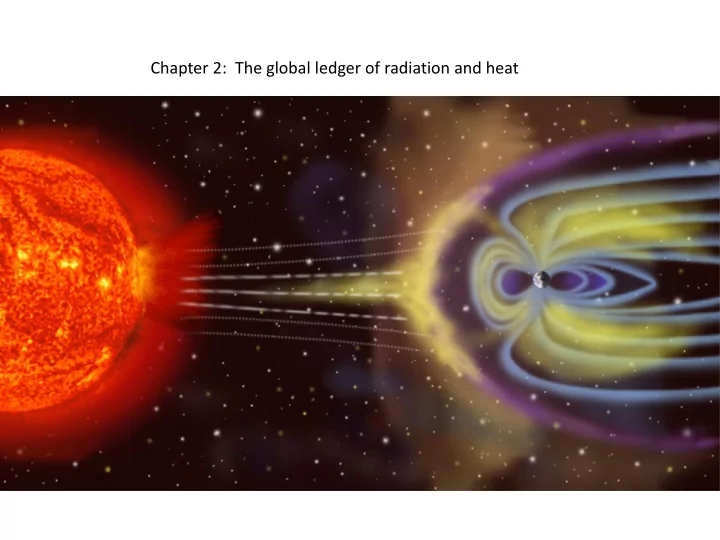

Chapter 2: The global ledger of radiation and heat
PROPERTIES OF RADIATION Everything radiates…at all wavelengths ! This includes the Sun, Earth, a candy bar, even us Fortunately, most objects don’t radiate a lot of X-rays, gamma rays, etc... However, different objects: Emit different amounts of radiation, and…. Emit their maximum radiation at different wavelengths (don’t confuse these two differences) So what’s the determining factor? TEMPERATURE!
PROPERTIES OF RADIATION 2 EASY RULES: 1. The higher the temperature, the more radiation an object will emit (Stephan-Boltzman Law) 2. Higher temperature result in radiation being concentrated at shorter wavelength (Wien’s Law)
Radiation Energy Transfer by Electromagnetic Waves Electromagnetic Spectrum VIOLET RED IR UV WAVELENGTH FREQUENCY ENERGY
PROPERTIES OF RADIATION Sun : 10,000°F ( solar, shortwave radiation ) 1. lots of radiation; 2. peak radiation in visible range Earth : 60°F ( terrestrial, longwave radiation ) 1. some (but much less) radiation; 2. peak radiation in infrared range
LOWER HIGHER
“Transparency” of the atmosphere by wavelength and atmospheric “windows”
SOLAR RADIATION & GEOMETRY • Not all parts of Earth receive the same amounts of radiation. Why? • TILT of our planet, 23.5
SOLAR RADIATION AND TILT
SOLAR RADIATION AND TILT
EARTH’S SEASONS
LAND OF THE MIDNIGHT SUN
Mechanisms of Energy Transfer (Heating): (Heat describes energy flow from hot -> cold, not amount of energy and object has) Conduction: Transfer of kinetic or vibrational energy by direct molecular collisions. What could maximize conduction efficiency? Convection: Spontaneous transfer of thermal energy by turbulent mixing in fluids. What conditions might maximize convection? Radiation: Transfer of energy by electromagnetic waves. Only mechanism that doesn’t need a medium for transfer. What could prevent radiative transfer?
How does direct radiation from the sun warm a cup of water (PS 2) ? ?
Simple Thermodynamic Relationships P( in W) = Power = Energy / time Q(in J)=Total Energy= Power x time x area P W incoming solar radiation density (power/are a) 2 A m P Q t A 1 A Q mc T P t A 1 A T m c
Assumptions in calculating Temp. warming: • No significant net heat lost by conduction, convection, or radiation (this is BS except for rare special circumstances) • All incident solar radiation is absorbed • Uniform temperature of object • Perfect styrofoam insulator J/kg/ o C cal/g/ o C Substance or J/kg/K or cal/g/K Water (0 o C to 100 o C) 4186 1.000 Methyl Alcohol 2549 0.609 Ice (-10 o C to 0 o C) 2093 0.500 Steam (100 o C) 2009 0.480 Benzene 1750 0.418 Wood (typical) 1674 0.400 Soil (typical) 1046 0.250 Air (50 o C) 1046 0.250 Typical Heat Capacities: Aluminum 900 0.215 Marble 858 0.205 Glass (typical) 837 0.200 Iron/Steel 452 0.108 Copper 387 0.0924 Silver 236 0.0564 Mercury 138 0.0330 Gold 130 0.0310 Lead 128 0.0305
EARTH’S ENERGY BUDGET • Energy from the Sun reaches the top of Earth’s atmosphere • Does all of it reach the surface? • NO • For example Ozone (O 3 ) absorbs UV • Clouds and gases scatter, absorb, reflect other types of radiation • Still, a lot of radiation (energy) reaches the surface of our planet.
EQUATOR NORTH POLE SOUTH POLE Most of the incoming solar radiation is absorbed at the Tropics
TERRESTRIAL RADIATION Amount of terrestrial radiation emitted from Earth’s surface and atmosphere is dependent on temperature More terrestrial radiation emitted near equator (warmer) Less terrestrial radiation emitted near poles (colder)
EQUATOR NORTH POLE SOUTH POLE
Earth’s Annual Energy Budget
EARTH’S ENERGY BUDGET Because of the differences in incoming/outgoing radiation on the Earth, we have an energy imbalance between the polar regions and the Tropics. So… winds and ocean currents exist to transport heat from the equator to the poles. TO CREATE AN ENERGY BALANCE
EQUATOR NORTH POLE SOUTH POLE
Average Emitted infrared radiation
Incoming solar radiation for August
Solar radiation absorbed yesterday
August solar radiation absorbed by surface
Sea Surface Temperatures
Sea Surface Temperature Anomaly
Recommend
More recommend